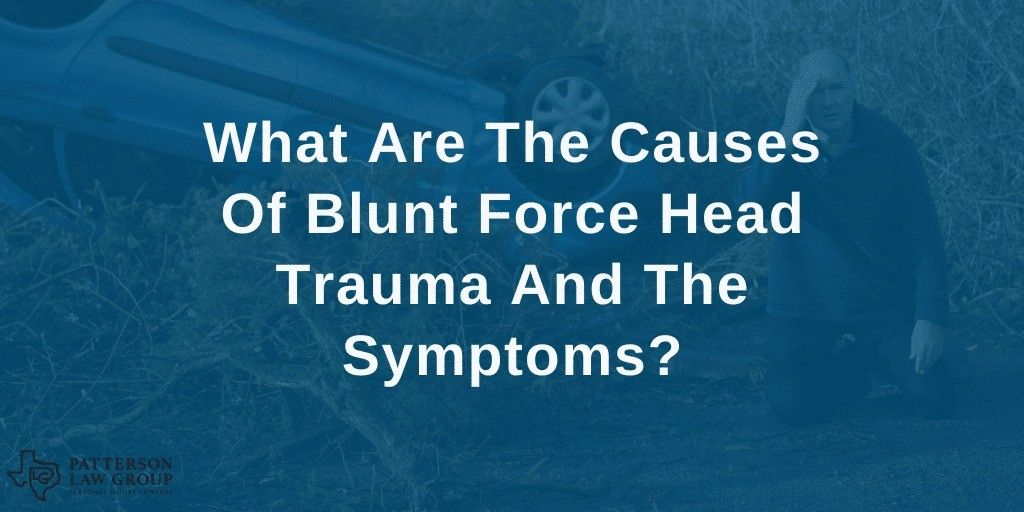Blunt force head trauma can be caused by various blows to the head that result in a significant jarring of the skull and the brain within and contusions, abrasions, lacerations, and fractures.
No injury is an enjoyable experience, but blunt force head trauma is one of the most painful and potentially dangerous injuries. Blunt force trauma aside from the physical damage cause can also lead to psychological issues such as communication, memory, and the ability to interact with the world around you.
Suffering through a car accident, a fall, or other similar experiences can easily lead to blunt force head trauma. If you have had to deal with head trauma due to some kind of accident, you should seek treatment immediately. It’s important to get professional guidance to prevent as many complications as possible.
If your injury is due to someone else’s negligence from a car accident, slip, and fall, or other situation, contact a personal injury lawyer at Patterson Law Group. We can help you start the process of getting compensation from those who caused your injury.
What is Blunt Force Head Trauma?
Blunt force head trauma is caused by the action of a blunt object (i.e., an object that is not sharp) hitting a part of your head. That initial hit causes trauma to your body, but it often leads to other injuries.
In most instances of blunt force trauma, a contusion or abrasion will occur. A contusion, more commonly called a bruise, occurs when the capillaries under the skin burst, though the skin remains intact. An abrasion occurs when the blunt force tears off the superficial layer of the epidermis.
If the force of the object lasts for several minutes, a person may suffer serious tissue damage or be crushed completely. Injuries from blunt force trauma may not be seen at first glance, so it is important to get medical treatment and monitor your health for several days following the initial trauma.
Speak To A Personal Injury Lawyer Now
Common Causes of Blunt Force Head Trauma
Various situations can cause blunt force head trauma, but the two most common causes are falls and motor vehicle accidents. Over 1.5 million cases of blunt force head trauma are recorded each year.
Head trauma is a leading cause of death for those under the age of 25, although 80% of those who suffer head trauma report only mild symptoms. Regardless, it is a dangerous and common injury.
The most common causes of blunt force head trauma are:
- Falls, especially from great heights
- Motor vehicle accidents
- Gunshot wounds
- Abuse such as punching or banging someone’s head against a wall
- Sports injuries (concussions)
- Explosive blasts (combat situation)
Blunt force head trauma is characterized by non-penetrating blows from dull objects or surfaces. This may include a steering wheel or another part of a vehicle in a crash, the ground, concussive force from a blast, etc.
Those most at risk for blunt force head trauma include children, elderly people, and males in general.

Symptoms of Blunt Force Head Trauma
Depending on the severity of the injury, there may be various symptoms of blunt force head trauma.
Mild trauma produces symptoms such as:
- Nausea and vomiting
- Headache
- Speech problems
- Fatigue and drowsiness
- Dizziness or balance loss
- Blurred vision
- Ringing in the ears
- Sensitivity to light or sound
- Memory problems
- Mood swings
- Moderate to severe trauma produces symptoms such as:
- Loss of consciousness for several minutes or hours
- Persistent and/or worsening headache
- Seizures
- Nausea and vomiting
- Pupil dilation
- Weakness or numbness
- Clear fluid draining from nose or ears
- Coordination loss
- Confusion
- Slurred speech
- Agitation
- Coma
In any situation where you suspect blunt force head trauma, make sure you see a doctor as soon as possible. It’s important to have a professional check your injury and provide the appropriate treatment.
Speak To A Personal Injury Lawyer Now
What are Examples of Blunt Force Injuries?
There are four main types of blunt force injury categories: contusions, abrasions, lacerations, and fractures. Each of these categories includes a variety of other associated injuries and conditions.
The most common injuries that result from blunt force trauma include:
- Blood clots
- Pulmonary embolisms (obstruction of one of the arteries that carry blood from the heart to the lungs)
- Aneurysms (expansion of an arterial wall that could result in rupture or severe pressure in the brain)
- Hydrocephalus (fluid buildup in the brain)
- Infections from cuts or bruises that may affect the brain
- Permanent nerve damage
- Miscarriages
- Spleen injuries
- Liver injuries
- Kidney injuries
- Bladder injuries
- Small and large intestine injuries
Contusions, or bruises, and abrasions are usually not severe injuries. However, lacerations and fractures could result in more serious injury, mainly if they affect the nerves or brain.
In addition to typical physical injuries, traumatic brain injuries often result in severe mental and emotional strain. Those suffering from traumatic brain injuries may experience memory loss, confusion, mood swings, depression and anxiety, insomnia, and difficulty speaking or communicating.
Contact a Brain Injury Lawyer
Anyone who has suffered from a blunt force head trauma injury is sure to face severe pain and continual difficulties in getting back to life as normal.
Lawyers at Patterson Law Group are dedicated to helping their clients recover. If you have had to deal with a brain injury because someone else caused your accident, we want to help you. We are experienced at understanding who is at fault in accidents and negotiating settlements favorable to our clients.
Are you struggling to overcome a brain injury and looking for help to ease some of your stress and financial burdens? With over 80 years of experience freeing our clients, we are standing by to help you! Don’t hesitate to call Patterson Law Group today.






